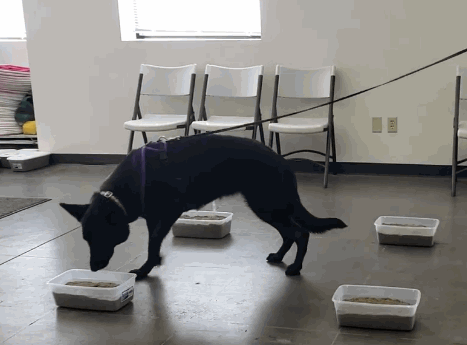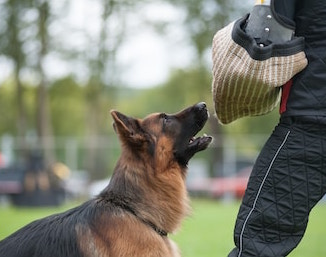K9 Nose Work
What is K9 Nose Work
K9 Nose Work is the specific term used to describe the canine scent detection activity developed by Ron Gaunt, Amy Herot & Jill Marie O'Brien. The three founders of the activity wanted to use their extensive experience from working in the professional canine detection world to give pet dogs and their people a fun and easy way to learn and apply scent detection skills, and so they crafted a new activity: K9 Nose Work.
In K9 Nose Work, dogs learn how to search for a specific odor or odors and find the source. Dogs start by searching for their favorite food or toy reward hidden in a variety of environments, increasing the challenges and adding new search skills as the dog progresses. Most people will choose to have their dogs learn to find the target odors used in K9 Nose Work: birch, anise, and clove; those looking to keep it fun searching for food or toy can still have fun and progress in the activity. Once target odors are introduced to the dog, he will search for the odor only and find its source, then get rewarded by his handler with his favorite food or toy reward.
K9 Nose Work introduces dogs to four different search elements: container, interior, exterior, and vehicles. Dogs build their hunt drive and learn foundational search skills in all four elements. Later stages of K9 Nose Work introduce advanced detection and handling skills to teams. Dogs are exposed to a myriad of complex search scenarios, while continuing to condition their foundational skills. Handlers sharpen their observational skills and learn when and how to take action during a search. Teams will practice searching to the competition standards set by the National Association of Canine Scent Work (NACSW), which includes searching for blind hides (location of hide unknown to handler), searching for multiple hides in a single search area, and, at the higher levels of competition, searching for an unknown number of hides in a search area.
K9 Nose Work is an activity that uses real-world environments and can be done almost anywhere. Every search has the potential to be a dramatically different & highly stimulating experience for both dog & handler, just by changing hide placement, or searching under different weather conditions. By participating in K9 Nose Work with your dog, you're giving him the freedom to express and refine his natural talents, and he's giving you a glimpse into how he "sees" the world.
Some of the many benefits of K9 Nose Work are:Dogs easily burn lots of mental & physical energy doing searches
Searches can be done anywhere you can take your dog
No prior training is required and no obedience is needed
In classes, dogs work one at a time and rest crated or safely in a vehicle between searches so reactive dogs can enjoy the activity, too
Shy or fearful dogs build confidence and overactive dogs put their energy into fun searches
Stronger bond between dog & handler as handler learns to observe, understand, and rely upon his dog
Any dog can learn K9 Nose Work. The training methodology is designed to help pet dogs tap into their hunting instinct, learn independent problem-solving skills, and to build broad and solid foundational scent detection skills that will enable them to successfully face new and greater challenges in K9 Nose Work.
For more information:
www.k9nosework.com
Geocaching
Geocaching is an outdoor recreational activity in which the participants use a Global Positioning System (GPS) receiver or mobile device and other navigational techniques to hide and seek containers, called "geocaches" or "caches", anywhere in the world.
A typical cache is a small waterproof container containing a logbook where the geocacher enters the date they found it and signs it with their established code name. After signing into the log, the cache must be placed back exactly where the person found it. Larger containers such as plastic storage containers (Tupperware or similar) or ammunition boxes can also contain items for trading, usually toys or trinkets of little financial value, although sometimes they are sentimental. Geocaching shares many aspects with benchmarking, trigpointing, orienteering, treasure-hunting, letterboxing, and waymarking. In the past this event was held at Afton State Park.
The park usually provides a multi cache that had 4 stages. After finding the first cache you get the coordinates to the next one and so on until you reach the final cache. Last time were able to reserve 5 GPS’s from the park and some of participants had phones with geocaching ability. There are various apps for this.
* We do not have a Geocach event scheduled at this time.
Schutzhund/IPO and the German Shepherd
Schutzhund is a German word meaning “protection dog.” It refers to a sport that focuses on developing and evaluating those traits in dogs that make them more useful and happier companions to their owners. Schutzhund work concentrates on three parts. Many are familiar with the obedience work of the American Kennel Club’s affiliates and will recognize the first two parts, tracking and obedience. The Schutzhund standards for the third part, protection work, are similar to those for dogs in police work.
While dogs of other breeds are also actively involved in the sport of Schutzhund and often follow similar criteria for breeding purposes, this breed evaluation test was developed specifically for the German Shepherd Dog. Schutzhund is intended to demonstrate the dog’s intelligence and utility. As a working trial, Schutzhund measures the dog’s mental stability, endurance, structural efficiencies, ability to scent, willingness to work, courage, and trainability.
This working dog sport offers an opportunity for dog owners to train their dog and compete with each other for recognition of both the handler’s ability to train and the dog’s ability to perform as required. It is a sport enjoyed by persons of varied professions, who join together in a camaraderie born of their common interest in working with their dogs. Persons of all ages and conditions of life even those with significant disabilities enjoy Schutzhund as a sport.
Schutzhund and the German Shepherd Dog
Schutzhund was developed in Germany in the early 1900s as a breed suitability test for the German Shepherd Dog. It was designed to test the natural instincts of the breed and to weed out the dogs that were either unstable or untrainable. This helped ensure that breeding stock would pass on the most desirable traits to working dogs such as police dogs, military dogs, and search and rescue dogs.
Over the past century Schutzhund has remained a breed test but has also evolved into a sport that can be enjoyed by people of all walks of life, from new dog owners to seasoned competitors. In many countries, Schutzhund titles are still considered prerequisites for breeding rights, and in some countries Schutzhund is called “The Versatility Test for Working Dogs.” It offers an opportunity for dog owners to compete with each other for recognition of both the handler’s ability to train, and the dog’s ability to perform as required. Persons of all ages and even those with significant disabilities are able to participate and enjoy the sport. Often it is a family hobby.
Contrary to the popular misconception that Schutzhund is “all about protection,” it is actually securely founded on obedience and control of a dog’s natural instincts and drives. Schutzhund dogs are safe, stable companions in the home and in public, good with children, under control, and at peace with their surroundings.
Why Schutzhund? Schutzhund is an advanced partnership with the dog – true teamwork. Rather than a mere few minutes of performance, it is a triathlon for dogs. Though known for its protection work, Schutzhund consists of three phases – Tracking, Obedience and Protection. Dogs must qualify in all three phases.
Schutzhund and similar sports/breeding suitability tests are vital for our dog community. Almost all police dogs, drug dogs, accelerant/bomb detection dogs and military dogs, as well as a very high percentage of search dogs, come from Schutzhund breeders and Schutzhund lines. Why? Because it still works as a breeding suitability test, and dogs from these lines are more likely to have the correct temperament and physical structure to do the work, saving thousands of dollars in “wash-outs” from untested lines.
Schutzhund and similar training preserves the breeds; Max von Stephanitz developed Schutzhund as a breeding suitability test for the German Shepherd Dog. Schutzhund offers excellent training and physical/mental outlet for the dogs. The socialization afforded by a good Schutzhund club is superb, and the Schutzhund dog gets far more physical exercise, mental stimulation, and sheer fun than most pets!
IPO Titles
IPO 1 For IPO 1 the dog must be at least 18 months old and pass an initial temperament test by the judge. In tracking, it must be able to follow a track laid by its handler at least 20 minutes earlier. In obedience, the dog must heel off leash, demonstrate the walking sit, the walking down, and the long down under distraction, as well as the send-out. It must retrieve on the flat and over a hurdle, and over the scaling wall. In the protection phase, the dog must search 2 blinds, perform escape and courage test exercises, and demonstrate a side transport.
IPO 2 For IPO 2 the dog must be at least 19 months old and must already have earned its IPO 1 degree. In tracking, the IPO 2 candidate must be able to follow a track laid by a stranger at least 30 minutes earlier.
It must again pass all of the obedience and protection tests required for the IPO 1 degree, but those tests, for IPO 2, are made more difficult and require greater endurance, agility, and, above all, control. There is an additional walking stand exercise required in obedience. In protection, the dog must search 4 blinds and demonstrate a back transport of the decoy in addition to the IPO exercises.
IPO 3 For IPO 3, the dog must be at least 20 months old and must have earned both the IPO 1 and the IPO 2 titles. Again, the tests now are made far more difficult. The track has four turns, compared with two turns for IPO 1 and 2, and there are three objects, rather than two, that must be found by the dog. The track must be laid by a stranger and be at least 60 minutes old. All exercises in obedience and protection are demonstrated off leash. The walking stand is replaced by the running stand. The picture of obedience, strength, eagerness, and confidence presented by an excellent IPO 3 team is a beautiful illustration of the partnership of human and dog.
For more information go to the United Schutzhund Clubs of America | www.germanshepherddog.com
Additional clubs:Minnesota Valley Schutzhund Verein | www.http://minnesotavalley.org
» Calendar
» Back to Index


